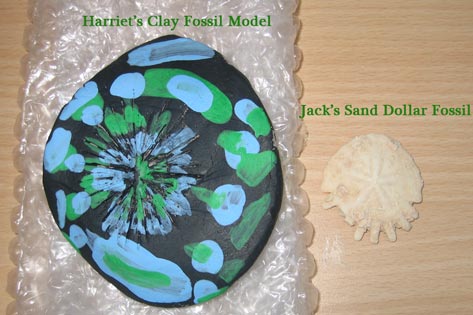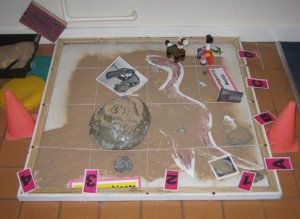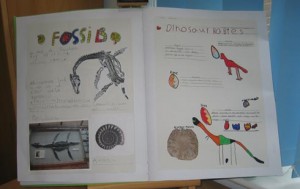Art and Science Combine in School During Fossil Study
School Children Make Models of Fossils as they Study Dinosaurs
Year 1 and Year 2 children at Hoylandswaine Primary School showcased their dinosaur and prehistoric animal knowledge this week during a school visit from a dinosaur expert at Everything Dinosaur. Under the tutelage of Miss Birkinshaw, the class teacher, the children had been studying dinosaurs and fossils with a special emphasis on food chains and the role of carnivores/herbivores in ecosystems.
Dig Site in the Classroom
A dig site had been created in the classroom, with Miss Birkinshaw and the children providing fossils for the budding young palaeontologists to excavate. A grid system had been overlaid and the children had been set a number challenges to identify and describe the objects located on various parts of the dig site. This reflects what we actually do when it comes to mapping an actual fossil excavation.
Primary School Children Map Out Their Own Fossil Excavations
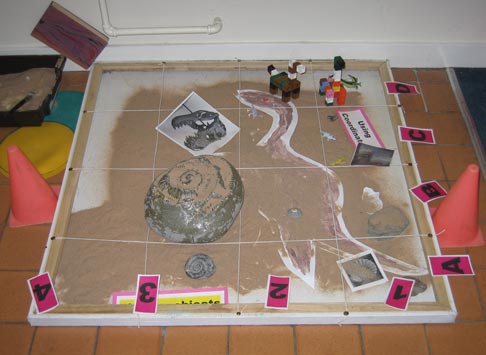
Palaeontology in schools – a wonderful exercise to help children learn more about fossils. Picture credit: Everything Dinosaur.
Picture credit: Everything Dinosaur
Some super ammonite fossils can be seen in the picture.
As part of the morning’s activities the children examined a variety of fossils including teeth from a giant prehistoric shark (O. megalodon) and with Harry’s help the size of the backbone of a Stegosaurus was compared to our own vertebrae. Mrs Burr (Teaching Assistant) and Miss Burkinshaw were appointed team captains as one half of the class were given the task of casting a replica shark fossil tooth, whilst the other half were challenged with casting a dinosaur toe bone which had come from a huge and very old duck-billed dinosaur, a specimen of a dinosaur called Edmontosaurus.
The children asked lots of questions and they learned some facts about Tyrannosaurus rex which meant that their poster display on the “King of the Tyrant Lizards” would have to be altered in the light of the information that they had been provided with. Lots of artwork and creative writing was on display and in the corridor close to the school office there was was a display that had been populated by various dinosaur themed objects and a special workbook that showed some of the areas of study that the children had been looking at.
School Dinosaur Project Book on Display
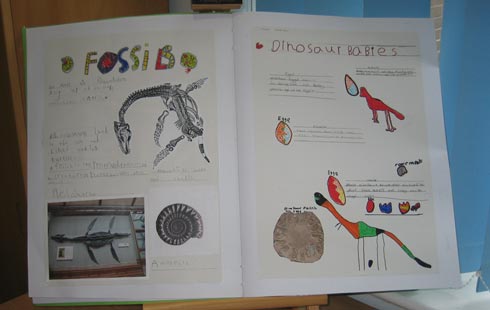
Children write about fossils and fossil discoveries in a superbly illustrated book all about prehistoric animals. Picture credit: Everything Dinosaur.
Picture credit: Everything Dinosaur
On the left-hand side of the book shows pictures of plesiosaur fossils (a marine reptile), fortunately, our expert had a piece of a plesiosaur vertebrae on hand to show some of the children who had stayed behind during lunch to ask further questions. Young Jack had brought in some of his own fossils. His fossil collection proved very handy when Harriet exhibited the fossil model she had made out of clay. Our expert was able to talk about the lines of symmetry in Harriet’s colourful model and then compare the clay fossil to a real “sand dollar” fossil in Jack’s fossil collection.
Comparing a Clay Model to a Fossil “Sand Dollar”
Picture credit: Everything Dinosaur
Models of Fossils
Harriet had done a wonderful job of making and painting her fossil. The lines radiating out from the centre reminded our dinosaur expert of the fossilised calcite plates associated with a type of sea urchin (Echinoids – pronounced “eck-in-oids”), often referred to as a “sand dollar”. “Sand dollars” fossils are relatively common, these animals are part of a group of sea creatures that originated around 480 million years ago (Ordovician), but most of the “sand dollar” fossils seen today are much more recent. Still, Jack’s fossil could be over twenty million years old.
The rigid external skeleton of a “sand dollar” is called a “test”. On the top surface, is a five pointed star-like structure, these are five paired rows of pores, like look a little like the petals on a flower. These pores can seen on Jack’s fossil. When the sea urchin was alive, tube feet projected through theses pores and these feet were multi-purpose, they helped the little animal to burrow into soft sediment, to move about and they also helped the animal breathe and to gather food.
Sand Dollars
“Sand dollars” are around today and often tests are washed up onto the beaches of the Western United States. These tests look like coins hence their common name, but they are also sometimes called “Mermaid coins”, in the past sailors used to believe that if they found one it would bring them good fortune on their next voyage.
Note for Harriet
Lots of different types of “sand dollar” sea urchins are alive today, and some are indeed coloured green and blue.
To conclude the visit, our dinosaur expert set the class a challenge. The children could write a thank you letter but they must use capital letters and connectives correctly. Perhaps they could write about their favourite dinosaur or indeed, include a special dinosaur fact in their letter.
We shall see what the budding young palaeontologists from Hoylandswaine Primary School come up with…
For further information on Everything Dinosaur’s range of toys, models and gifts: Dinosaur Toys, Gifts and Models.


